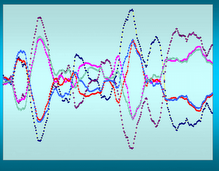Again from Wikipedia. All of us B-School Majors learn about this in school and some of us take it into the real world and use it to build funds and funds of funds or even to invest our own money.
It is what is used to model the expected performance of an asset against the totality of a portfolio. Thus a stock can be bought or sold in quantities that optimize its presence within the portfolio.
In other words a stock's price can go up or down based on the way it fits within a large fund.
For example some months ago Kirk Kirkorian sold off his shares in GM because he was in a snit about the fact that they weren't listening to him (he's just made an offer for Chrysler - apparently he believes there is a future in the auto business). More than his shares were sold though because by selling he changed the beta of the stock and a lot of funds had to rebalance as a result. Thus the share price declined more than if it had just been Kirkorian's sales.
Here's the chart -

There's so much going on in this chart it becomes a clinic in its own right. First we have Kirk's snit (KK sells). Then, because the CAPM gets disturbed everyone else sells (EE sells) (disclosure - I sold with Kirk).
This culminated in a short squeeze and a BOB which I bought and closed the very next day for a small profit. This was followed by a tweezer bottom plus a BOB. I was done with GM at the moment so I didn't buy this one.
The ATR then finally settled and if you look at this chart over a period of time you will see that it is a good time to buy when the ATR is below 60 cents. And generally a good time to sell when it gets above 90 cents.
I didn't know about Philip's set-up at that time but it too is on this chart.
So the next time you are wondering why a stock dropped it can drop for any number of reasons - but the reason why it goes up again - an attractive stock becomes more attractive when you don't have to pay as much for it. Notice that within two and a half months of Kirk's snit the stock was higher than when it started.

No comments:
Post a Comment